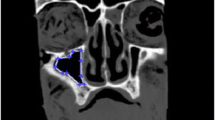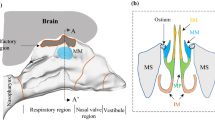Abstract
Acoustically driven nebulized drug delivery (acoustic aerosol delivery) is the most efficient noninvasive technique for drug delivery to maxillary sinuses (MS). This method is based on the oscillation of the air plug inside the ostium to transport drug particles from the nasal cavity (NC) to the MS. The larger the wavelength of the air plug oscillation in the ostium, the greater the penetration of drug particles to the MS. However, using this technique, the maximum drug delivery efficiency achieved to date is 5%, which means 95% of the aerosolized drugs do not enter the MS and are wasted. Since the largest amplitude of the air plug oscillation occurs at its resonance frequency, to achieve an improved MS drug delivery efficiency, it is important to determine the resonance frequency of the nose–sinus combination accurately. This paper aims to investigate the impact of geometrical parameters on the resonance frequency of the nose–sinus model. Both experimental and computational acoustic models, along with the theoretical analysis, were conducted to determine the resonance frequency of an idealized nose–sinus model. The computational modeling was carried out using computational fluid dynamics (CFD) and finite element analysis (FEA), whereas in the analytical solution, the mathematical relationships developed for a conventional Helmholtz resonator were employed. A series of experiments were also conducted to measure the resonance frequency of a realistic NC–MS combination. The results demonstrated a good agreement between the experimental and CFD modeling, while the FEA and theoretical analysis showed a significant deviation from the experimental data. Also, it was shown that the resonance frequency of the idealized nose–sinus model increases by up to twofold with increasing the ostium diameter from 3 to 9 mm; however, it has an inverse relationship with the ostium length and sinus volume. It was also reported that the resonance frequency of the nose–sinus model is independent of the NC width and MS shape.



















Similar content being viewed by others
Abbreviations
- cyl:
-
Cylindrical
- CFD:
-
Computational fluid dynamics
- CRS:
-
Chronic rhinosinusitis
- DE:
-
Deposition efficiency
- EPW:
-
Elements per wavelength
- FS:
-
Frontal sinus
- FEA:
-
Finite element analysis
- MS:
-
Maxillary sinus
- Mic:
-
Microphone
- NC:
-
Nasal cavity
- NC–MS:
-
NC and MS combination
- PSD:
-
Power spectral density
- sph:
-
Spherical
- rec:
-
Rectangular
- SS:
-
Sphenoid sinus
- TF:
-
Transfer function
- \(\alpha\) :
-
Acoustic attenuation coefficient
- \(c\) :
-
Speed of sound (m/s)
- \(C_{xy}\) :
-
Coherence function between x and y
- \(c_{\text{p}}\) :
-
Specific heat for constant pressure (J/mol K)
- \(c_{\text{v}}\) :
-
Specific heat for constant volume (J/mol K)
- \(D_{{{\text{H}},{\text{os}}}}\) :
-
Hydraulic diameter of the ostium (m)
- \(D_{\text{os}}\) :
-
Ostium diameter (m)
- f :
-
Frequency (Hz)
- \(F_{\text{r}}\) :
-
Resonance frequency (Hz)
- \(\gamma\) :
-
Specific heats ratio
- \(G_{xy}\) :
-
Cross-power spectral density between input and response (\({\text{Pa}}^{2} / {\text{Hz}}\))
- \(G_{xx}\) :
-
Power spectral density of input (\({\text{Pa}}^{2} / {\text{Hz}}\))
- \(G_{yy}\) :
-
Power spectral density of response (\({\text{Pa}}^{2} / {\text{Hz}}\))
- \(\kappa\) :
-
Thermal conductivity (W/m K)
- \(\lambda\) :
-
Wavelength (m)
- \(\lambda_{i}\) :
-
Characteristic velocity (m/s)
- \(L_{s}\) :
-
Ostium length (m)
- \(L_{\text{eq}}\) :
-
Equivalent length of the ostium (m)
- \(\mu\) :
-
Dynamic viscosity (kg/m s)
- \(\mu_{0}\) :
-
The reference value of density (kg/m s)
- \(\nu\) :
-
Kinetic viscosity (\({\text{m}}^{2} / {\text{s}}\))
- \(\omega\) :
-
Angular frequency (Hz)
- \(P\) :
-
Pressure (Pa)
- \(p_{0}\) :
-
Gauge pressure (Pa)
- \(p_{i}\) :
-
Pressure amplitude (Pa)
- \(Q\) :
-
Quality factor
- \(\rho\) :
-
Fluid density (\({\text{kg/m}}^{3}\))
- S :
-
Effective temperature (K)
- \(S_{0}\) :
-
Ostium cross-sectional area (m2)
- \(T\) :
-
Temperature (K)
- \(T_{xy}\) :
-
Transfer function estimate
- U :
-
Velocity (m/s)
- V MS :
-
Maxillary sinus volume (mL)
- w in :
-
Incident sound power at inlet
- w t :
-
Transmitted sound power at outlet
- W NC :
-
Nasal cavity width (mm)
- \(\zeta\) :
-
Damping ratio
References
Alciatore DG (2007) Introduction to mechatronics and measurement systems. Tata McGraw-Hill Education, New York
Alster M (1972) Improved calculation of resonant frequencies of Helmholtz resonators. J Sound Vib 24:63–85. https://doi.org/10.1016/0022-460X(72)90123-X
ANSYS (2015) ANSYS mechanical, 16.1st edn. Canonsburg, Pennsylvania
Beck A, Munz C-D (2018) Direct aeroacoustic simulations based on high order discontinuous Galerkin schemes. In: Kaltenbacher M (ed) Computational acoustics. Springer, Cham, pp 159–204. https://doi.org/10.1007/978-3-319-59038-7_4
Bendat JS, Piersol AG (2011) Random data: analysis and measurement procedures, vol 729. Wiley, Hoboken
Bies DA, Hansen C, Howard C (2017) Engineering noise control. CRC Press, New York
BioDigital (2019) Human complete anatomy. https://human.biodigital.com/index.html
Cankurtaran M, Çelik H, Coşkun M, Hizal E, Cakmak O (2007) Acoustic rhinometry in healthy humans: accuracy of area estimates and ability to quantify certain anatomic structures in the nasal cavity. Ann Otol Rhinol Laryngol 116:906–916
Durand M et al (2011) Impact of acoustic airflow nebulization on intrasinus drug deposition of a human plastinated nasal cast: new insights into the mechanisms involved. Int J Pharm 421:63–71
Durand M et al (2012) Sonic aerosol therapy to target maxillary sinuses. Eur Ann Otorhinolaryngol Head Neck Dis 129:244–250
El Merhie A, Navarro L, Delavenne X, Leclerc L, Pourchez J (2016) A new strategy to improve drug delivery to the maxillary sinuses: the frequency sweep acoustic airflow. Pharm Res 33:1074–1084
FLUENT (2008) Tutorial: modeling aeroacoustics for a Helmholtz resonator using the direct method (CAA), 6.3rd edn. Centerra, USA
FLUENT A (2009) User Guide (Release 12.0) Chapter, vol 24, pp 1315–1434
Grace SM Tutorial (2004) Computational methods in aeroacoustics. In: ASME IMECE
Granqvist S, Sundberg J, Lundberg JO, Weitzberg E (2006) Paranasal sinus ventilation by humming. J Acoust Soc Am 119:2611–2617
Hallberg CJ, Lysaught MT, Zmudka CE, Kopesky WK, Olson LE (2014) Characterization of a human powered nebulizer compressor for resource poor settings. Biomed Eng 13:77
Harbo G, Grau C, Bundgaard T, Overgaard M, Elbrønd O, Søgaard H, Overgaard J (1997) Cancer of the nasal cavity and paranasal sinuses: a clinico-pathological study of 277 patients. Acta Oncol 36:45–50
Hood CM, Schroter RC, Doorly DJ, Blenke EJ, Tolley NS (2009) Computational modeling of flow and gas exchange in models of the human maxillary sinus. J Appl Physiol 107:1195–1203
Howard CQ, Cazzolato BS (2014) Acoustic analyses using Matlab® and Ansys®. CRC Press, New York
Howard CQ, Cazzolato BS, Hansen CH (2000) Exhaust stack silencer design using finite element analysis. Noise Control Eng J 48:113–120
Huang S-F, Lee T-J, Lin K-L (2005) Concomitant bilateral orbital and brain abscesses–unusual complications of pediatric rhinosinusitis. Chang Gung Med J 28:51–55
Hyo N, Takano H, Hyo Y (1989) Particle deposition efficiency of therapeutic aerosols in the human maxillary sinus. Rhinology 27:17–26
Kumar H, Jain R, Douglas RG, Tawhai MH (2016) Airflow in the human nasal passage and sinuses of chronic rhinosinusitis subjects. PloS One 11:e0156379. https://doi.org/10.1371/journal.pone.0156379
Lam K, Hirsch AG, Tan BK (2014) The association of premorbid diseases with chronic rhinosinusitis with and without polyps. Curr Opin Otolaryngol Head Neck Surg 22:231–241
Laube BL (2007) Devices for aerosol delivery to treat sinusitis. J Aerosol Med 20:S5–S18
Leclerc L, Pourchez J, Aubert G, Leguellec S, Vecellio L, Cottier M, Durand M (2014) Impact of airborne particle size, acoustic airflow and breathing pattern on delivery of nebulized antibiotic into the maxillary sinuses using a realistic human nasal replica. Pharm Res 31:2335–2343
Maniscalco M, Weitzberg E, Sundberg J, Sofia M, Lundberg J (2003) Assessment of nasal and sinus nitric oxide output using single-breath humming exhalations. Eur Respir J 22:323–329
Maniscalco M, Sofia M, Weitzberg E, Lundberg J (2006) Sounding airflow enhances aerosol delivery into the paranasal sinuses. Eur J Clin Invest 36:509–513
Moghadam SJ, Navarro L, Leclerc L, Hodin S, Pourchez J (2018) Toward smart Nebulization: engineering acoustic airflow to penetrate maxillary sinuses in chronic rhinosinusitis. Int J Pharm 546:188–193
Möller W, Münzing W, Canis M (2010) Clinical potential of pulsating aerosol for sinus drug delivery. Expert Opin Drug Deliv 7:1239–1245
Möller W, Lübbers C, Münzing W, Canis M (2011) Pulsating airflow and drug delivery to paranasal sinuses. Curr Opin Otolaryngol Head Neck Surg 19:48–53
Möller W et al (2013) Topical drug delivery in chronic rhinosinusitis patients before and after sinus surgery using pulsating aerosols. PloS One 8:e74991. https://doi.org/10.1371/journal.pone.0074991
Möller W, Schuschnig U, Bartenstein P, Meyer G, Häussinger K, Schmid O, Becker S (2014) Drug delivery to paranasal sinuses using pulsating aerosols. J Aerosol Med Pulm Drug Deliv 27:255–263
Rau JL (2005) The inhalation of drugs: advantages and problems. Respir Care 50:367–382
Si XA, Xi J, Kim J, Zhou Y, Zhong H (2013) Modeling of release position and ventilation effects on olfactory aerosol drug delivery. Resp Physiol Neurobiol 186:22–32
Sharma SK, Jehan M, Kumar A (2014) Measurements of maxillary sinus volume and dimensions by computed tomography scan for gender determination. J Anat Soc India 63:36–42
Sutherland W (1893) The viscosity of gases and molecular force. Lond Edinb Dublin Philos Mag J Sci 36:507–531
Tam CK (1995) Computational aeroacoustics-Issues and methods. AIAA J 33:1788–1796
Tarhan E, Coskun M, Cakmak O, Celik H, Cankurtaran M (2005) Acoustic rhinometry in humans: accuracy of nasal passage area estimates, and ability to quantify paranasal sinus volume and ostium size. J Appl Physiol 99:616–623
Thompson KW (1990) Time-dependent boundary conditions for hyperbolic systems II. J Comput Phys 89:439–461
Weitzberg E, Lundberg JO (2002) Humming greatly increases nasal nitric oxide. Am J Respir Crit Care Med 166:144–145
Xi J, Yuan JE, Si XA, Hasbany J (2015) Numerical optimization of targeted delivery of charged nanoparticles to the ostiomeatal complex for treatment of rhinosinusitis. Int J Nanomed 10:4847–4861
Xi J, Si XA, Peters S, Nevorski D, Wen T, Lehman M (2017) Understanding the mechanisms underlying pulsating aerosol delivery to the maxillary sinus: in vitro tests and computational simulations. Int J Pharm 520:254–266
Acknowledgements
Financial support for the project has been provided by the Australian Government Research Training Program (RTP), and the Beacon of Enlightenment PhD Scholarship provided by the University of Adelaide. The authors would like to acknowledge the support of the School of Mechanical Engineering, Phoenix High Performance Computing (HPC), and the workshop at the University of Adelaide.
Author information
Authors and Affiliations
Corresponding author
Ethics declarations
Conflict of interest
The authors declare that they have no conflicts of interest.
Additional information
Publisher's Note
Springer Nature remains neutral with regard to jurisdictional claims in published maps and institutional affiliations.
Rights and permissions
About this article
Cite this article
Pourmehran, O., Arjomandi, M., Cazzolato, B. et al. The impact of geometrical parameters on acoustically driven drug delivery to maxillary sinuses. Biomech Model Mechanobiol 19, 557–575 (2020). https://doi.org/10.1007/s10237-019-01230-5
Received:
Accepted:
Published:
Issue Date:
DOI: https://doi.org/10.1007/s10237-019-01230-5




